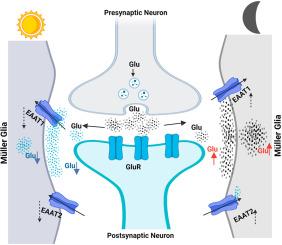视网膜上皮细胞谷氨酸摄取活性:昼夜节律调节
IF 2.7
2区 医学
Q1 OPHTHALMOLOGY
引用次数: 0
摘要
视觉通路的信号传递是由谷氨酸进行的,谷氨酸是脊椎动物大脑中主要的兴奋性神经递质。嗜离子性和代谢性受体介导这种氨基酸的作用。突触外谷氨酸浓度的严格调控是其受体作为昼夜循环功能的选择性激活所必需的。此外,适当的额外突触谷氨酸水平调节对于避免兴奋性毒性损伤也很重要。在胶质细胞中表达的质膜谷氨酸转运蛋白家族负责清除突触间隙中的这种氨基酸。考虑到已经建立的光依赖性谷氨酸释放差异,我们决定评估突触神经胶质谷氨酸转运体的表达和摄取活性,因为这些细胞负责超过90%的视网膜谷氨酸摄取活性。为此,我们使用了Moorfields/Institute of ophthalmology - m本文章由计算机程序翻译,如有差异,请以英文原文为准。

Glutamate uptake activity in retina Müller cells: Circadian modulation
Signal transmission in the visual pathway is carried by glutamate, the major excitatory neurotransmitter in the vertebrate brain. Ionotropic and metabotropic receptors mediate the actions of this amino acid. A tight regulation of extra-synaptic glutamate concentrations is needed for the selective activation of its receptors as a function of the day/night cycle. Moreover, proper extra synaptic glutamate levels regulation is also important for the avoidance of an excitotoxic insult. A family of plasma membrane glutamate transporters expressed in glia cells carries out the clearance of this amino acid from the synaptic cleft. Taking into consideration the well-established light-dependent differential glutamate release, we decided to evaluate the expression and uptake activity of Müller glia glutamate transporters, since these cells are responsible for more than 90 % of the total retinal glutamate uptake activity. To this end, we used the Moorfields/Institute of Ophthalmology-Müller 1 cell line and a rat retina Müller glia primary culture synchronized through a 50 % serum strategy. The glutamate transport activity was evaluated with a [3H] D-Aspartate uptake assay. A time-dependent differential glutamate transporter regulation was present demonstrating that the night/dark cycle regulates the transporter function. This data supports the notion that Müller glia has intrinsic photoreceptor properties and further strengthens the role of radial glia cells in retina physiology.
求助全文
通过发布文献求助,成功后即可免费获取论文全文。
去求助
来源期刊

Experimental eye research
医学-眼科学
CiteScore
6.80
自引率
5.90%
发文量
323
审稿时长
66 days
期刊介绍:
The primary goal of Experimental Eye Research is to publish original research papers on all aspects of experimental biology of the eye and ocular tissues that seek to define the mechanisms of normal function and/or disease. Studies of ocular tissues that encompass the disciplines of cell biology, developmental biology, genetics, molecular biology, physiology, biochemistry, biophysics, immunology or microbiology are most welcomed. Manuscripts that are purely clinical or in a surgical area of ophthalmology are not appropriate for submission to Experimental Eye Research and if received will be returned without review.
 求助内容:
求助内容: 应助结果提醒方式:
应助结果提醒方式:


